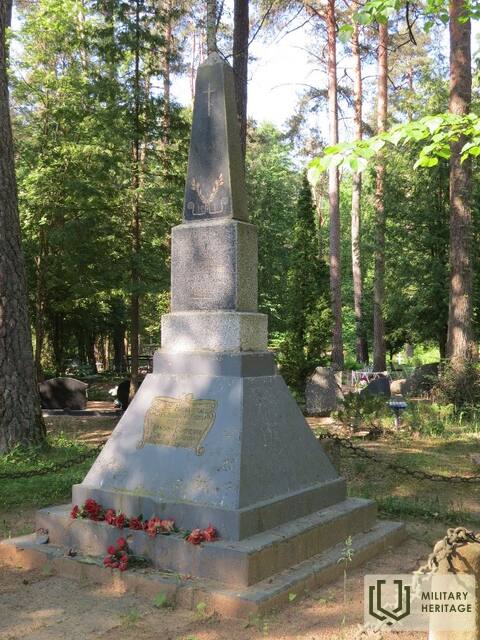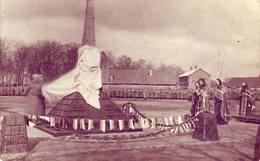About the soldiers of the 3rd Caucasian Rifle Regiment who were shot in Jēkabpils during World War I for inciting disobedience to orders
On May 18, 1916, at 8:30 p.m. in the ruins of the Ķēģeri manor house (~7 km south of Jēkabpils, beyond Brodie), soldiers of the 3rd Caucasian Rifle Regiment were shot for inciting disobedience to orders. The execution was led by Ensign Ravņjaļičevs.
In March 1916, fierce fighting took place at the Jēkabpils bridgehead. Here, the commander-in-chief of the Northern Front, N. Ruzskis, had planned to break through the German 8th Army front with far-reaching plans – to capture Panevezys. However, only at the beginning of the attack did the 5th Army units in some places in the Jēkabpils district manage to advance 2 to 3 km. The enemy's counterattack forced them to return to their starting positions.
Anti-war propaganda intensified in the 5th Army. In the Daugavpils district, units of the 6th Siberian Rifle Corps even refused to carry out combat orders. Among the dissatisfied were also soldiers of the 3rd Caucasian Rifle Regiment of the 5th Army, stationed on the Jēkabpils bridgehead front. The officers were informed by the messengers who spoke most actively against the war and urged them to follow the example of the Siberians and disobey orders.
On the morning of May 18, 1916, the commander of the 3rd Caucasian Rifle Regiment, Colonel Areshev, ordered the arrest of the regiment's riflemen - Corporal Alexei Kuznetsov, Privates Gerasim Serichenkov, Grigory Yalunin, Alexei Sokolov, Semyon Chukur and hand them over to a military court. By order No. 141, Colonel Areshev appointed Lieutenant Colonel Rudnev as the chairman of the field military court, and Captains Ivanov and Vorontsov, Staff Captains Bek-Zeinalov and Petrov as members.
Corporal A. Kuznetsov and rifleman G. Serichenkov were accused of intentionally spreading rumors among the soldiers. The “crime” of riflemen G. Yalunin, A. Sokolov and S. Tsukurs was the same as that of their comrades, but it was formulated that it was committed out of recklessness. The field court-martial session was short. The judges unanimously found the accused A. Kuznetsov, G. Serichenkov and G. Yalunin guilty of inciting soldiers with the prior intention of causing disorder in the regiment, and in the front line. Therefore, in accordance with Article 246, paragraph 1, of Volume XXII of the Code of Laws, they were sentenced to death by shooting. Riflemen A. Sokolov and S. Tsukurs were acquitted, since their guilt was not proven.
The verdict of the field court-martial was immediately handed over to the regiment commander, and Colonel Arshev wrote a resolution and verdict: “I confirm the verdict of the court. I order Ensign Ravnalichev to execute it.”
In 1917, after the overthrow of the Tsar, the ashes of the killed were reburied by their comrades in the Jēkabpils cemetery, and a monument was also erected, but it was not completed. The monument was restored in 1950.
Inscription on the monument:
3rd CAUCASIAN
STRYLKOVAGO POLKA
ARROWS
ГЕРАСИМ СРЕЧЕНКО
SEMYON KUZNETSOV
GRIGORY YALUNIN
Iluta Bērziņa, Jekabpils History Museum
Related objects
The fraternal cemetery of Russian soldiers of the First World War
Located at the beginning of the Jēkabpils State Gymnasium alley towards the main entrance to the school.
It is erected above the grave in memory of the Russian soldiers of the 3rd Caucasian Rifle Regiment who fell in 1915. 139 soldiers and two officers who fell on September 1, 1915 near Jēkabpils, during the attack aimed at breaking the front towards Panevezys, are buried in the fraternal cemetery.
Inscription on the obelisk:
3rd CAUCASIAN RIFLE REGIMENT HEROES OF OFFICERS AND SHIFTERS. ЗА ВЕРУ ЦАРЯ И ОТЕЧЕСТВА В СЛАВУ РУССКОГО ОРУДИЯ НА ПОЛЕ БРАНИ ПАВШИМ 1-GO SENTYABRYA 1915 ГODA В ОКРЕСТНОСТЯХ ЯКОБШТАТА. THERE IS NOTHING MORE THAT I LOVE, THAT SOMEONE WOULD PUT THEIR SOUL FOR THEIR FRIENDS.
Inscription on the concrete base:
GLORIOUS SMERTH BESLAVIYA KRASHE.
There is also a limestone plaque with the names of 78 fallen soldiers and officers.
The monument is surrounded by concrete pillars connected by cast iron chains.
The author of the monument is Jēkabpils stonemason J. Sieriņš.






